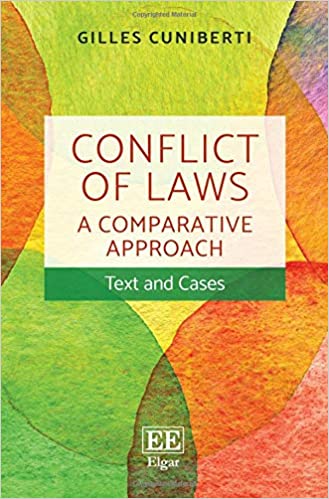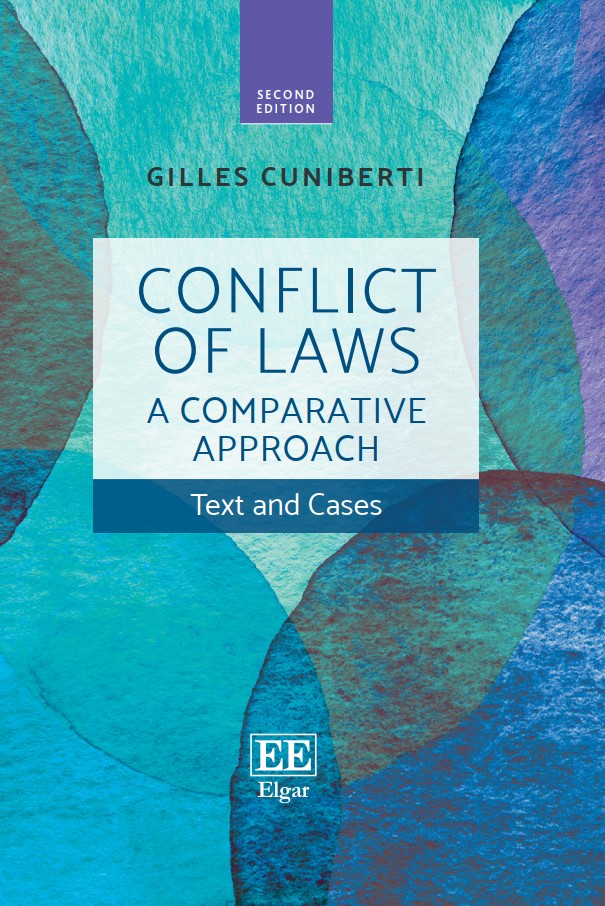Conflict of Laws – A Comparative Approach
Conflict of Laws – A Comparative Approach Elgar, 2nd ed. 2022.
Now in its second edition, and with significant updates and new material, Gilles Cuniberti’s innovative textbook offers a comparative treatment of private international law, a field of great importance in an increasingly globalized world. Written by a leading voice in the field, and using a text and cases approach, this text systematically presents and compares civil law and common law approaches to issues primarily within the United Kingdom, United States, France and the EU, as well as offering additional updated insights into rules applicable in other jurisdictions such as Japan, China and Germany.
Key features of the second edition include:
• New topics covered in the fields of jurisdiction and foreign judgments
• Original discussions surrounding the 2019 Hague Convention on Judgments and the changes contemplated by the new US Restatement on Conflict of Laws
• US, EU, French and English perspectives integrated throughout the text to ensure maximum relevance and encourage students to make comparative assessments
• Carefully selected extracts from primary and secondary sources that build a clear picture of the field, as well as expert analytical commentaries and questions that set these extracts in context.
Offering a unique comparison between the civil law and common law perspective, this revised and updated edition will be a key resource for students in private international law and conflict of law courses. Conflict of Laws: A Comparative Approach will also help to train lawyers who not only know the law of their own jurisdiction, but also need to have an understanding of the key differences between models, in order to be able to interact successfully with clients from other jurisdictions.
‘The coming out of a second edition of this book is particularly welcome. The reality of nowadays’ world, indeed, makes the adoption of a transnational perspective in the study of private international law particularly deserving, making it rather short-sighted to persist in a purely national or regional attitude in addressing the subject. A further distinguishing feature of this textbook lies in its methodological approach, based on a direct confrontation with cases, arising from the practice of various jurisdictions. This second edition introduces important updates, with a fresh discussion of new cases and more recently adopted legislation, particularly from the EU side, keeping up with the unceasing development of the subject.’
Fabrizio Marongiu Buonaiuti, University of Macerata, Italy
‘A comparative perspective on private international law is essential in a globalized world of constantly interacting legal systems. Yet there is a dearth of teaching materials offering such a perspective. This makes Professor Cuniberti’s Conflict of Laws: A Comparative Approach an especially important contribution to the field. Reflecting the author’s expertise in both comparative law and private international law, the second edition continues to offer both a valuable teaching resource and a useful point of departure for research on comparative private international law.’
Christopher A. Whytock, University of California, US
‘The teaching of private international law is perhaps ever more needful in today’s interconnected world where even the most apparently local of cases can turn out to have x-border implications. Accordingly any students who aspire to legal practise will benefit from a basic understanding of the principles. As Cuniberti has correctly identified the best way for students to understand this complex subject is to start with the cases and the commentary upon them; in this sense this latest edition of Conflict of Laws is a hugely valuable teaching tool, bringing all the content together in one volume making it accessible in terms of length and price.’
Diana Wallis, University of Hull, UK
‘Flipping through the book one meets the terms and jargon that can make PIL so mysterious, such as lis pendens, forum non conveniens, ‘comity’ (including the famous 1895 Hilton v Guyot case from the US Supreme Court), the reciprocity requirement (including references to laws of Germany, Egypt, China and Israel) or recognition of judgments. All in all, a fascinating and eclectic picture of legal rules where the lecturer can help the student to understand these better. And certainly worthwhile is a companion website of the publisher to make available additional or updated materials or supplements of materials, e.g. to large to print.’
Bob Wessels, Leiden University, NL (full review available here)

About the first edition:
While comparison has always been important in the conflict of laws, it is crucial today, in a context of accelerated exchange and diversified societies. But the materials have become, correlatively, so abundant that teaching a satisfactory class in this field is now a considerable challenge. Cuniberti has selected and assembled the most significant sources from various legal traditions, and guides the student through each carefully constructed chapter by a series of questions, US case book style. An excellent pedagogical tool!
Horatia Muir Watt, Sciences Po Law School, France
Als Fazit ist festzuhalten, dass Cuniberti kenntnisreich eine beachtliche Menge an Material zu Kernproblemen des Internationalen Privat- und Zivil-verfahrensrechts zusammenträgt. Das auf bereitete Fallmaterial umfasst sowohl „klassische Fälle“ als auch wichtige neuere Entscheidungen, etwa zur internationalen Zuständigkeit US-amerikanischer Gerichte in Produkthaftungsf ällen. Die Entscheidungen und sonstigen Quellen sind ansprechend redigiert und können daher im Unterricht gut eingesetzt werden. Da zudem Gesetzestexte aus ganz unterschiedlichen Jurisdiktionen abgedruckt sind, wird – soweit dies im Rahmen eines Lehrbuchs möglich ist – in gelungener Weise ein vielschichtiges Bild der Behandlung grenzüberschreitender Rechtsverhältnisse gezeichnet.
Wolfgang Wurmnest, RabelsZeitschrift für ausländisches und internationales Privatrecht
La publication d’un livre comme celui-ci est digne d’éloges à plusieurs égards. C’est loin d’être une nouveauté que d’affirmer que le droit comparé est inséparable du droit international privé. Néanmoins, ces deux disciplines sont rarement mises ensemble de façon systématique et articulées dans l’enseignement. La contribution de l’auteur, qui est un spécialiste reconnu des deux disciplines, est à cet égard remarquable. () il existe au moins quatre raisons justifiant le besoin d’enseigner le droit international privé sur une base comparative. Premièrement, la vie de la plupart des personnes, tant physiques que morales, n’est plus exclusivement rattachée à un seul ordre juridique, même à supposer que ces personnes ne sortent jamais de leur domicile ; deuxièmement, les ordres juridiques sont eux-mêmes pluraux, c’est-à-dire qu’ils ont plusieurs dimensions (et la dimension étatique n’est pas la plus importante dans tous les cas) ; troisièmement, le droit en général est en cours d’internationalisation et supranationalisation ; enfin, non moins important, l’accès à la connaissance du droit étranger s’est considérablement amélioré dans les dernières décennies.
Diego Fernandez Arroyo, Revue Critique de Droit International Privé
L’Autore perviene cosı a identificare convergenze e divergenze, inspecial modo, tra il ‘‘sistema’’ dell’Unione europea e quello degli Stati Uniti d’America, con particolare riferimento al primo e al secondo Restatement on Conflict of Laws e alla governmental interest analysis, sotto il profilo del metodo e degli istituti di parte generale, quali i profili della qualificazione, delle questioni preliminari, del trattamento processuale delle norme di d.i.p. e del diritto straniero applicabile, offrendo altresı ad un tempo chiavi di accesso ai multiformi approcci e soluzioni adottati nei diversi Stati nordamericani e riflessioni attente sulle conseguenze pratiche derivanti dalle variegate impostazioni accolte nei diversi ordinamenti, capaci di instillare un’attitudine al ragionamento orientato al problem solving e di ispirare anche al lettore piu smaliziato nuove chiavi di ragionamento.
Francesca Villata, Rivista di diritto internazionale privato e processuale
Το εν λόγω σύγγραμμα αποτελεί ένα καινοτόμο εγχειρίδιο, που προσεγγίζει το Ιδιωτικό Διεθνές Δίκαιο μέσα από μία συγκριτική θεώρηση, με πλούσιες αναφορές στη νομολογία […] Το βιβλίο χαρακτηρίστηκε από την καθηγήτρια Horatia Muir Watt ως ένα εξαιρετικά παιδαγωγικό εργαλείο. Πράγματι, η δομή που επέλεξε ο συγγραφέας διαφοροποιείται από αυτή των κλασσικών εγχειριδίων, που γνωρίζει και ο Έλληνας νομικός στο πλαίσιο του ΙΔΔ. Η προτίμηση αυτή πηγάζει ενδεχομένως και από τη διδακτική εμπειρία του Cuniberti σε αγγλόφωνες νομικές σχολές. Πρόκειται άρα για σύγγραμμα που κινείται περισσότερο σε πλάτος, και λιγότερο σε βάθος. Το εύρος του πρώτου είναι πραγματικά δυσεύρετο σε αντίστοιχα έργα, δεδομένο που μας επιτρέπει να μην σταθούμε με κριτική διάθεση στην έλλειψη βάθους. Και αυτό διότι πρόκειται για συνειδητή επιλογή του συγγραφέα.
Apostolos Anthimos, Armenopoulos
The author leads the reader through the field from the beginning to end in a most satisfactory way and is “perfectly pitched for international students and courses with a global outlook” as the cover suggests and is a great complement to an undergraduate’s growing law library.
The Barrister Magazine

